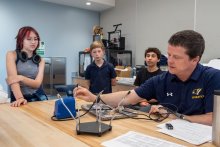
Written by Gil Gallagher, Middle School Director
Teachers are constantly assessing what students know and can do—and we’re often assessing things we didn’t know we needed to assess or teach. At Field, we’ve done tremendous work over the last five years distinguishing between assessment and grading, and getting this distinction right has been foundational to everything else we do.
Assessment is the ongoing process of gathering evidence about student learning—looking carefully at what students do, say, and create to understand both what they know and can do and what they might need next. It’s a rich, complicated, and nuanced process that taps deeply into both the “art” and the “science” of teaching.
Assessment is constant: it happens through conversation, through observation of small-group discussions, through careful examination of student work, and in dialogue with the students. Critically, assessment is also a teaching tool—it reveals what students need next and whether my assumptions about their prior knowledge are accurate.
At Field, we believe in giving students meaningful and authentic challenges. We adjust classroom instruction to meet the needs of our students. This responsive approach helps students develop a deeper understanding of the material and builds their confidence as learners. This evidence often shows up in our assessments.
The first unit in my Middle School Coding and Making class teaches students the design thinking process and how it works. The final product is a sketchbook that my students will use in class, featuring a cover design that will allow others to “see them,” both literally and figuratively.
As students engaged in the design thinking process, they:
Throughout the unit, students documented their process, capturing notes on their thinking at different stages, including interview questions and notes, initial sketches, plans for revision, and a reflection on their design process. They did all of this before they even started binding their sketchbooks. While the sketchbook was the final product of the unit and evidence of my students’ hard work, it didn’t significantly factor into my assessment of their learning.
One student referred to the physical sketchbook as the “summative” assessment and worried that slightly crooked pages might hurt his grade. I stepped in to clarify: he had already handed in everything I would use to evaluate his learning for this unit. The physical product was not part of my assessment of his Design Thinking learning.
I began by using the construction process to assess prior knowledge and skills—and this is where assessment became a crucial teaching tool. I had designed this project assuming students would come in with specific foundational technical skills, such as using tape, cutting materials, following sequential instructions, and threading a needle. What I discovered was humbling and changed my teaching: I had significantly overestimated their experience with some basic materials and tools. This is what I call “ground-truthing”—testing my assumptions about what students know rather than taking prior knowledge for granted. Many of my students had never cut gaffer tape (or duct tape!) before or threaded a needle. They didn't know they needed to hold the tape taut while cutting, or that the tape would just stick to the scissors, or that they needed a clean cut on the thread to get it through the eye.
This kind of discovery is particularly crucial in middle school. Students arrive in sixth grade from vastly different elementary experiences, and they’re developing at dramatically different rates—physically, cognitively, and emotionally. A student might demonstrate sophisticated critical thinking by asking deep questions while still struggling with fine-motor tasks like holding a utility knife. Another might have developed some technical skills but needs support with brainstorming and ideation. The tape-and-needle example perfectly captures this reality: these are students sophisticated enough to use terms like “summative assessment” and to worry about how their work will be evaluated; these same students may also have never threaded a needle before.
Middle schoolers exist in this fascinating in-between space where we can’t assume anything about their prior knowledge or skills. They're old enough that we might expect certain elementary skills to be solidified, but they’re still young enough that significant gaps are completely normal—and often invisible until a task reveals them. Some students have spent time in elementary school in maker spaces or working in their parents’ garages, while others have had limited hands-on learning. Some experienced COVID disruptions during critical skill-building years. And beyond external factors, they're simply at different developmental stages: executive function, fine motor control, and spatial reasoning are all still actively developing and maturing.
As educators, when we meet students where they are, we help students build the skills they need without assuming what they “should” know. No student is penalized for gaps in knowledge because we seek to fill those gaps as part of the learning process. Our assessment philosophy develops students who:
As my students build on this foundation in design thinking, I’ll continue assessing their growth and adjust to meet them where they are. By the end of the year, we will translate all that rich evidence into grades that represent genuine learning and will serve the student well beyond the classroom.
I joked with a colleague that I wasn’t expecting my class that day to be focused on cutting tape or threading needles—but this is exactly how assessment functions as a teaching tool. It tells me what students need next. In real time, I shifted from facilitating bookbinding to teaching technical skills. That’s assessment informing instruction immediately.
